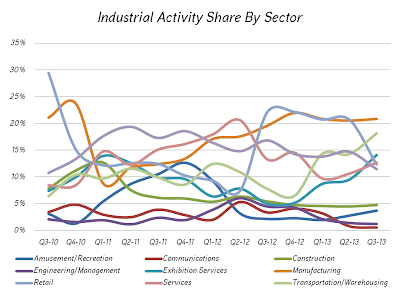In today’s post, I want to examine how the landscape of commercial real estate had changed over the past three years in terms of tenant industry (i.e. what line of business the tenants were in). This is new ground for me, so I decided to begin with the industrial market, examining what share of industrial lease and user sale activity different industries held.
If you think this graph did not help increase my understanding of the situation, you are correct. Different industries have, on a quarter by quarter basis, had their ups and downs, but the only industries to show a trend were manufacturing and construction, and those trends were pretty slight.
To get a better handle on the situation, and gain some context, I decided to abandon my relatively small sampling of lease and sales activity data for a much broader store of data – employment.
When we look at jobs in Southern Nevada, we see surprisingly little change over the past twenty years in the share of jobs between different sectors. The only significant changes have been in the construction sector and leisure and hospitality sector.
The construction sector held 9 percent of the region’s jobs in 1994, swelled to a colossal 12 percent in 2005/2006, and has now fallen to just 6 percent of the region’s jobs. While a farmer with nine cows and one pig could create the illusion of farmyard diversification by killing eight of his cows, he certainly would not be better off than when he started. Having 2,000 fewer construction jobs now than in 1994 has not improved economic diversification in Southern Nevada.
The leisure and hospitality sector, on the other hand, has added almost 107,000 jobs over the past 20 years, but has seen its share of the job market shrink from 35 percent to 32 percent. Perhaps this is not a massive drop, but one that is indicative of some diversification of employment. Over the same period, the share of employment in the professional and business services sector and the education and health sector have both increased by 3 percentage points. Again, this may largely be a matter of the draw-down in construction jobs, but both sectors have shown percentage growth in excess of 140 percent over the past twenty years, adding a combined total of 113,900 jobs. It seems likely that the leisure and hospitality sector has lost some of its employment share to these two service industries.
This may not be the diversification some folks want, but it’s the diversification we have for now.

